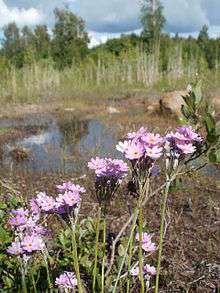Rich fen

Rich fen is a type of fen that is rich in calcium, with a pH around 6-8, but nutrient poor. These special conditions have given the rich fens a specialized and species rich flora, which often consists of orchids, sedges and mosses (Rydin et al. 1999). The rich fens are often classified into the categories moderately rich fen and extremely rich fen. The extremely rich fens have a higher pH and more vascular plants (Rydin et al. 1999).
Threats
Historically rich fens have been used as meadows and pastures, but the practices ceased during the 20th century (Emanuelsson 2009). Many wetland areas, among them the rich fens, were drained in the 19th and 20th century to create new agricultural land or to increase productivity in the forestry (Emanuelsson 2009). There are several other threats though, that might cause degradation and loss of rich fens such as acidification, eutrophication and overgrowth by trees and bushes because of lack of management. Habitat fragmentation is an ongoing threat that leads to reduced connectivity within the landscape. Small and isolated fragments hold in general fewer species than larger and less isolated areas. One reason is that it is more difficult for the species to disperse between the isolated fragments (Hunter et al. 2007).
References
Emanuelsson, 2009. The rural landscapes of Europe – how man has shaped European nature. Formas, Värnamo.
Hunter M and Gibbs J. 2007. Fundamentals of conservation biology. Third edition. Blackwell Publishing, Singapore.
Rydin H, Snoeijs P, Diekmann M. 1999. Swedish plant geography. Swedish Society of Plant Geography, Uppsala.